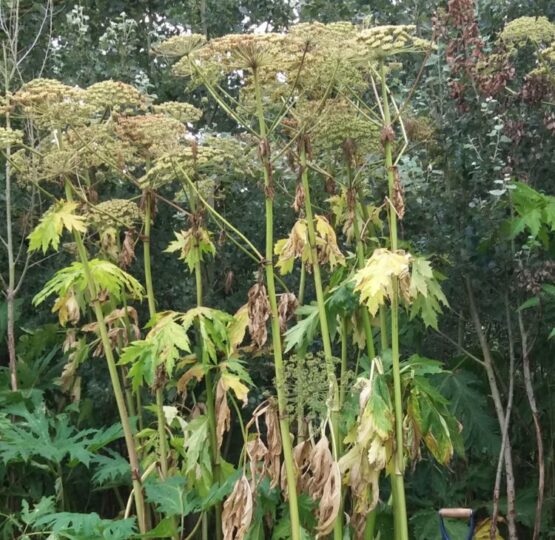Non-Native Invasive Plants
The Dedham Vale National Landscape and Stour Valley (DVSV) are working to tackle non-native invasive plants (NNIP) in the Stour Valley.
The DVSV have been working on collaborative projects with the Environment Agency since 2012 to raise awareness of key NNIP in the Stour Valley, initiate control/eradication works and to expand the knowledge of NNIP distribution throughout the Stour catchment.
The key NNIP that currently pose a threat in the River Stour catchment are:
- Giant Hogweed (Heracleum mantegazzianum)
- Japanese Knotweed (Fallopia japonica)
- Himalayan Balsam (Impatiens glandulifera)
- Floating Pennywort (Hydrocotyle ranunculoides)
- Water Fern (Azolla filiculoides)
- New Zealand pigmyweed (Crassula helmsii)
Further information on NNIPs can be found on the Plantlife website

Giant Hogweed
As part of the River Stour Enhancement Project, Peter Cosgrove (River Stour Project Officer) is working with a wide range of different individuals and groups to stop the spread of NNIPs through the catchment.
Giant Hogweed is currently being controlled at 75 different riverside sites in the River Stour Catchment across Essex and Suffolk. Originating in the Caucasus Mountains in south west Russia, Giant Hogweed is now classified as ‘common’ in the United Kingdom and has been spreading on the rivers Stour, Brett and Glem.
Since 2015 the DVSVP has been controlling Giant Hogweed on these rivers which has led to a significant reduction in Giant Hogweed’s distribution and abundance in the Stour Valley.
Great care should be taken not to touch Giant Hogweed with bare skin because it contains a poisonous sap which reacts with sunlight which can lead to significant burns and blistering of the skin.

Himalayan Balsam
Himalayan Balsam is the most widespread and abundant non-native invasive plant species in the Stour Valley.
It has escaped from gardens and is particularly suited to riparian habitats. If Himalayan Balsam is not controlled it can cause environmental problems such as out competing native plants and river bank erosion in the winter. It is able to spread so quickly due to its explosive seed pods which can fire out seeds up to 8m.
The River Stour Project Officer along with volunteers have been controlling Himalayan Balsam since 2014. Fortunately, Himalayan Balsam is very shallow rooted and can be easily removed by hand pulling. Volunteers have helped to remove Balsam from its source on the rivers Stour, Box and Lavenham Brook.
